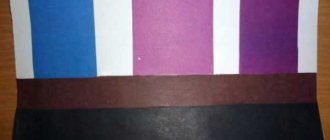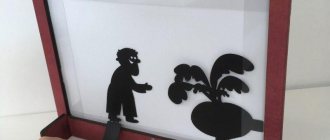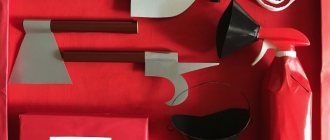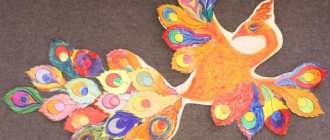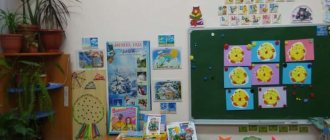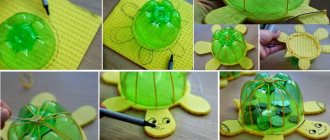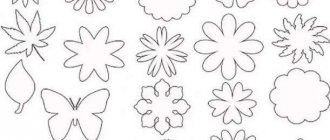Types of puppet theaters and materials
Any parent can create their own home theater. You can also involve a child in this matter. Surely in this case the process will be more fun, and the baby will be busy.
For work, something that many people will definitely have at home is suitable. Even some waste materials will come in handy, so don’t rush to scrap them.
It could be:
- Disposable plastic tableware,
- Felt,
- Boxes of different shapes and sizes,
- Colored paper/cardboard,
- Rolls of paper towels, foil or toilet paper
What types of dolls are there?
- Stationary
- On hand
- Finger
Paste
Special modeling material is perfect for creating figures. It is replaced with ordinary plasticine, and salt dough is also made. Ordinary figurines and finger products are created from such materials.
It is difficult for a child to sculpt, so parents will need help. If the figurine is ready, you should wait for it to dry. Then you can start painting it.
Paper
Paper is one of the simplest and most accessible materials for creating crafts on the theme of puppet theater.
Choosing a piece
You will need to decide in advance on the characters of your theatrical production in order to find suitable templates for the paper finger theater. Most often, for the very first children's productions, teachers and psychologists advise taking simple, long- familiar fairy tales and stories. On the Internet you can often find templates for finger theater made of paper for such fairy tales as Turnip, Teremok, Kolobok, Masha and the Bear, Three Little Pigs and so on /
When organizing a holiday for a child, it is important to take into account all the nuances. One of the main things is not only impressions, but also memories that need to be recorded. You can order lively and bright photographs from children's parties here at an affordable price. A team of professionals will capture all the brightest moments and convey the most vivid emotions in the photographs.
In any case, you should take for the game a work or story from a book that is familiar to your child. Perhaps you have even been to a real puppet theater, have already seen some kind of play, and the child liked the plot.
First way
You will need:
- Paper or cardboard,
- Cereal box/desired size,
- Plastic straws,
- Wooden sticks,
- Glue,
- Scissors,
- Paints,
- Pencils.
Progress:
- On thick paper, depict the characters of the chosen fairy tale or story.
- After they are cut out, glue tubes or sticks on the inside.
- The box will act as a stage, so you will need to cut out the "screen" or one of the larger sides.
- A slot is also made in the lower part. Prepared figures of heroes on sticks should be inserted there.
Such a theater is either installed on a stand or hung around the neck thanks to a ribbon attached to the box.
Secrets of successful theater productions
How to make a paper theater more durable? After all, paper parts often tear and become unusable. And, most likely, this will happen after the first production of your play. Here is another option for making a theater at home, which, although more time-consuming, will last longer.
The first stage of production remains unchanged - we find templates (you can even draw them yourself if there are no ready-made ones). We print them on a color printer. Then we cut out the largest decorations, glue them to cardboard and additionally seal them with tape - this will add strength to them, and they will not get dirty.
Then we start making fairy tale heroes. At this stage we will need additional materials, namely:
- Small plastic jars for yoghurts like Rastishka or Agusha.
- Wooden ice cream sticks (if you don’t have them, plastic forks or spoons will also work).
- Stationery knife.
We cut out the characters and glue them onto a cardboard base. If your paper is quite thick, then you don’t have to do this. But most often, thicker paper is not “grabbed” by the printer for printing. Keep this in mind and try using different paper weights in your printer.
Be sure to tape it with tape to prevent the parts from fraying. Then we take ice cream sticks or plastic spoons and tape them with tape to the back of the paper blank so that the stick is “behind” the hero and has a free part at the bottom (3-4 cm). Using a utility knife, we make two cuts on the bottom of the yogurt jar - you should get a cross - and then simply insert the stick with the doll into this hole. All is ready! You can start playing!
As you can see, a home theater is a great way to diversify a child’s leisure time without much expense, because printing and cutting out the templates is not at all difficult. In addition, this is a good option for spending time together, which children always like, and also strengthens family relationships.
Second way
As a base for the characters' bodies, either homemade paper tubes or ready-made paper towels or toilet paper are used.
Depending on whether the doll will fit on your hand or on your finger, the size itself is selected. The scene is also made out of the box, as in the previous version.
This craft can be made for kindergarten or for some event.
Methodological recommendations “TYPES OF THEATER IN KINDERGARTEN”
Theater is a magical world. He gives lessons in beauty, morality and ethics. And the richer they are, the more successful the development of the spiritual world of children is…” (B. M. Teplov)
Theater is one of the most vibrant, colorful and accessible spheres of art for a preschooler. It develops imagination and fantasy, promotes the creative development of the child and forms his personal culture. Theatrical activities help children to relax, develop communication skills, increase self-esteem, develop speech, the emotional sphere and simply bring bright, unforgettable variety to everyday life, enriching the child’s inner world.
TYPES OF THEATER IN KINDERGARTEN /traditional and non-traditional/
1 Wrist theater
This type includes theatrical activities, which require attributes such as finger puppets or “glove” toys. There are the following “wrist” types of theaters in kindergarten:
- finger;
- glove
What is needed to organize such theatrical activities? First of all, you need a screen. Its size depends directly on the size of the characters. In turn, dolls are most often made independently by the teacher. But students can also take an active part in creating characters. For example, you can make finger puppets from cardboard cones, fabric, tennis balls and other materials.
“Glove puppets” can be made, for example, from a mitten or sock, sewing the necessary elements (face, hands, clothes, etc.) to the base.
It is important to note that finger theater, in addition to other advantages, effectively develops fine motor skills of preschoolers, which, in turn, directly affects the formation of children’s speech.
FINGER
These are dolls made of fabric, glued from paper or knitted from wool and thread. The pattern follows the contour of an outstretched finger of an adult or child or the contour of the palm. The doll should fit freely on any finger or hand of the puppeteer. The character's face can be embroidered, glued or sewn on using buttons, beads, threads, ropes, pieces of wool, colored paper, fabric. Children play behind a screen or in direct contact. For a finger theater, together with your child, you can draw or glue any character from a fairy tale from colored paper, then stick it on thin cardboard, and sew or glue a wide elastic band on the back side, put it on your finger and play. For the mitten theater, you can use unnecessary children's mittens. Each child involved in the performance works with only one doll. Children find intonations and movements of a particular character on their own or with the help of an adult. The performance is well accompanied by music or songs that children know.
Stomper Theater
It’s quite easy to make characters for the stomper theater from old gloves, cutting off everything unnecessary and leaving only two fingers. You can make a pattern of characters and sew them from knitwear. It is better to draw the head on cardboard, then sew it to the figure or glue it, after which the remaining details of the character are sewn on.
MITTEN DOLLS
Puppets for this theater can be made from sewn or knitted mittens, but mitten dolls made of paper are of particular interest to children. Children place the pattern on paper, trace it, carefully cut it out and glue it together. Then the mitten dolls are decorated with paints, felt-tip pens, appliqué, etc. You can even make part of the decorations on such mittens, for example, trees, bushes and much more.
2 Tabletop theater
The name of this type of theater speaks for itself - play activities are carried out on the table. Its peculiarity is that the scenery and characters must be small in size so that it is possible to place all the necessary attributes of the game on the surface. What is a tabletop theater like in kindergarten?
- Paper (cardboard). Often such a ready-made theater can be found in some children's magazine - you just need to cut out and assemble all the necessary parts and you can start the performance.
- A theater made of natural material, for example, cones, chestnuts, acorns, etc. It is convenient to place such characters in a box of sand.
Toy Theater
These are flat or ordinary toys that children play with every day. Stage area - children's table. You can make a character for a tabletop theater yourself from any available material: pine cones, acorns, roots; from household materials: milk and kefir bags, shoe boxes. If you take old skittles and cut off the bottom, and then trim or tie them, you will get a tabletop theater puppet. To decorate the doll, buttons, beads, wool, fabric, specially tied ears, noses, eyes, hair, paws and tails are used…. These dolls can be put on your hand, on a gapit, or on a thread. The teacher sits at the children's table, and the children sit in a semicircle in front of him. Children should not see the toys that the teacher will use to show the performance. The teacher, without masking his hands, takes toys in front of the children, moves them and speaks for them. Such a performance of toys, despite its great simplicity and primitiveness, is not devoid of theatricality; Both toddlers and older children watch it with great interest. For the performance, it is recommended to take scenes specially written for showing them with toys: “Matryoshka and Katya”, “Game of Hide and Seek”, “Adventures of Toys” and others. You can come up with similar scenes for the puppet theater yourself or use individual plots from children's literature. You just need to remember that their content should be extremely simple, without difficult, impossible actions and movements for toys. The toy show is designed for a small group of children. It is shown not in the hall at the holiday, but in the group room. The purpose of such displays is to entertain and please children, to make the doll more interesting for them, and to help them add variety to their play activities.
3 Horse Theater
What is a horse theater? This term was introduced by Russian puppeteers back in the 16th century. Its peculiarity is that the dolls are taller than the person who controls them. There are the following types:
- Reed theater uses puppets, which are mounted on a high cane, and the person who controls the characters is hidden behind a screen.
- The Bi-ba-bo theater is becoming increasingly popular. In principle, this is the same “glove”, since the dolls are put on the hand. The only difference is that a high screen is used and, thus, the characters are shown to the audience at a level higher than the puppeteer’s height.
- No less interesting is the theater of spoons in kindergarten. It is very easy to make attributes for such gaming activities yourself. For this you will need a wooden spoon. The character’s face is drawn on its convex part, and the clothes of a fairy-tale hero are put on the handle. During a children's play, little puppeteers hold spoon characters by the handle.
Stock doll
.(cockerel, ducklings, dog, bear, etc.). These dolls are driven with the help of one or two rods (sticks). They are very useful for the development of fine motor skills, which contributes to the development of speech in children. These dolls also develop flexibility in the fingers, hand and wrist. When working with young children, dolls on one rod are used. The teacher teaches how to hold the doll with all fingers (in a fist). The doll moves due to the movements of the hand. Older children control the dolls on two rods. To manipulate such dolls, you need to teach children to hold the sticks only with their fingertips.
Mastering stock dolls.
At stage 1, the teacher shows a performance in which he introduces children to new dolls.
At stage 2, the exercise “Download, sticks!”
Exercise “Stoolka”. A stoolka is a stick with a flat circle at the end, to which threads with balls are attached on both sides. You need to hold the stick with three fingers (thumb, index and middle), and if you twist the stick with your fingertips, the balls will hit a flat circle. Children enjoy playing with the doll and at the same time they develop the skills necessary for puppeteering.
At stage 3, a theatrical game is held, during which children learn to move a doll along the edge of the screen. The teacher gives everyone a stock doll and improvises a fairy tale in which all children must participate.
Bi-ba-bo puppet theater (or "Petrushki" theater)
The Petrushki Theater is a theater whose puppets are worn on three full fingers of the hand - like a glove. In Italy, these dolls used to be called burattini, now they are called pupattzi. In Russia, this puppet character was named Petrushka. Petrushka traveled from fair to fair for a long time, until in 1924 he finally found his home in St. Petersburg. And it was then that a permanent puppet theater for children was organized. These dolls can be purchased at children's stores or made by yourself. The simplest doll consists of a shirt body, a head and arms. The body-shirt is cut from fabric according to the puppeteer's hand. The head can be made of different materials: wood, bread, plasticine, a plastic ball, but usually papier-mâché. Or you can use old dolls or rubber toys that you may be planning to throw away. If you take the head of a rubber doll and sew a new costume onto it (so that a child’s hand fits through it), then the doll will come to life, and it can be used in theatrical performances. The doll is put on like this: on the index finger - the head, and on the thumb and middle finger - the arms or paws. If the doll is too heavy for a small child, then a gapit (a wooden rod with a comfortable rounded handle) comes to the rescue. The stage of the parsley theater is a screen. The scenery is placed on it, and the action takes place. Behind the screen there are puppeteers who control the puppets and speak for them. Puppet theater brings children a lot of joy and pleasure, creates a good mood in them and is vividly reflected in their creative games.
4 Stand theater
A stand theater is a surface on which character figures and decorations are attached. This type includes:
- Theater on flannelgraph (board covered with fabric). To organize this type of activity, you will need an industrial or self-made flannelgraph and figurines-characters of the selected work of art, on which you need to attach Velcro to the back side. Thus, as the plot develops, the child is invited to attach the necessary figures to the flannelgraph.
- Magnetic is essentially the same as the previous type, only a metal board is used, and magnetic strips are attached to the figures instead of Velcro. The basis and, accordingly, the characters of such a theater come in very different sizes: from a small tabletop version to a full-fledged screen for an auditorium or music hall.
- Shadow theater in the gardens is the most mysterious and unusual for children to perceive; preschoolers enthusiastically participate in such a game. To organize this type of theater you will need a screen (white fabric stretched vertically), a lantern or table lamp (depending on the size of the screen), and black cardboard figures. Instead of using toy characters, shadows can be created directly with your hand and fingers. This type is called “living shadow theater”.
Shadow theater
Shadow theater is a joyful and welcome entertainment. Children love to watch how figures of people, animals and birds move on a brightly lit screen. A fairy tale, story, poem, song can be accompanied by showing shadows. Expressive performance of musical and literary works, when skillfully demonstrated, evokes a wide variety of emotions in children. The stage of the shadow theater is the screen. The screen frame of the shadow theater is made of wood or thick cardboard and decorated with ornaments. The screen is covered with thin white material. When shown, the shadow theater figures are pressed tightly against the material on the back of the screen. A light source is placed behind the screen. The silhouettes of the figures are made of thin cardboard and painted black on one side. Some parts of the silhouettes (arm, leg, head, etc.) can be made movable (attached with thread or wire). Pulling the string sets the figurine in motion: the arm, head, etc. are lowered or raised. When showing silhouettes, the puppeteer's hand should not be visible. Therefore, each figurine must have an additional part by which this figurine is held. Many interesting fairy tales and other literary works loved by children can be shown in the shadow theater. Theater on flannelgraph
Children listen and watch the illustrative display with flannelgraph with great interest. They are amazed by the unusualness of the spectacle: the pictures do not fall, they stay on the board like magic. Older children immediately begin to become interested in the technique of making pictures and the flannelgraph itself. Children are even more surprised when the teacher tells them that they themselves can show such a picture theater to the kids. Children enthusiastically begin to prepare for the upcoming performance. For illustrative display with flannelograph by older children, we can recommend the following literary works: “Toys” by A. Barto, “Toys” by A. Akhundova, “What is good and what is bad?” V. Mayakovsky, “Merry Count” by S. Marshak, “They Gave You Nothing” by N. Naydenova, “Tanya Got Lost” by Z. Alexandrova, “Once Upon a Time There Lived a Baby Elephant” by G. Tsyferov, “Ladder” by E. Shabal. Children should know these works by heart. Each work can be told and shown by several children at once. For this type of theater you will need a piece of plywood covered with soft flannel (preferably in two layers) - this is the screen. You can draw pictures for display yourself (these are plots or characters from fairy tales, stories), or you can cut them out of old books that can no longer be restored. They are glued onto thin cardboard, and flannel is also glued to the back side. These pictures can be laid out and moved on the table, and if you attach a stick (gapit) to the figure, you can perform a performance using the edge of the table as a screen. Another option is also possible: a thread is attached to the top of the picture (in this case the picture is drawn on both sides) and the picture is moved near the surface of the floor, table….
5 Floor theater
Floor theater uses puppets. Making them yourself is quite difficult, so most often they are purchased in specialized stores. Due to this feature, this type of theatrical activity is rarely carried out in kindergartens. But it is the puppet theater that evokes a storm of emotions and delight in preschoolers. Since children do not yet understand the mechanism of action of such dolls, children imagine that the toys themselves have “come to life”. It is this element of “miracle”, “fairy tale” that contributes to the emergence of positive emotions in preschoolers.
Puppet theater
These dolls have one end of the threads attached to the head, arms, legs, and torso, and the other to the vagina. The vaga is a tool for controlling the puppet: by controlling the vaga, the actor makes the puppet move. These dolls promote the development of coordination of movements, help the child learn to concentrate attention on one object, and develop the flexibility of fingers and hands.
Mastering puppets.
At stage 1, the teacher introduces children to a puppet doll. She can dance, approach each child, and talk to him.
At stage 2, an exercise with “Funny Shoes” is recommended.
Funny shoes are a tool for preparing to drive puppets, as well as for developing hand coordination. “Funny shoes” are easy to make yourself: you need to take a small stick, attach thin ropes to both ends. Bags with weights in the form of shoes are sewn to the ends of the ropes.
Sequence of exercises:
1. Rearrange the shoes one by one, holding the shoe with 2 hands.
2. Rearrange the shoes one by one, holding the shoe with one hand.
3. One shoe goes around the other. The vaga is held with both hands, the hands move as the vaga rotates.
4. One shoe goes around the other in a semicircle and returns. The vaga is held with one hand.
5. Both shoes jump at the same time. The vaga is held with both hands.
6. Both shoes jump at the same time. The vaga is held with one hand.
7. Rotate the shoes, i.e., use both hands to rotate the shoe clockwise, then back. It turns out to be a pinwheel.
At the 3rd stage, the game “Walk with my toy” is played. Children with puppets walk to cheerful music, and then pass their toy to another child.
At stage 4 – performance. To music of a different nature, children manipulate dolls, performing one at a time and observing all stages of the performance (exit-performance-bow-exit).
6 Living Puppet Theater
But more often than others, a “live” puppet theater is organized in kindergarten. Such activities can be carried out as a lesson on the development of speech, the surrounding world, learning a foreign language, as well as during leisure time. In addition, a live theater production can be dedicated to a holiday, for example, Maslenitsa or New Year.
The following types of described gaming activities are distinguished:
- masque;
- theater of giant puppets.
The latter is most often carried out as a leisure activity in a preschool educational institution. The roles of giant dolls are played either by adults or older preschoolers. Younger children can only act as spectators.
Then the mask theater is suitable for children of any age. Even the youngest pupils have the opportunity to “reincarnate” into the hero of a fairy tale. The teacher can invite the children to retell a story the kids love in such an unusual way or prepare a full-fledged performance for their parents.
Preschoolers can make masks for the upcoming performance on their own under the guidance of a teacher, for example, during classes on artistic and aesthetic development or during leisure activities.
Scarf dolls
These dolls are called so because they are made of scarves. A scarf is attached to the doll's head, and elastic bands are sewn to its edges.
The head is attached to the puppeteer’s neck, and elastic bands are attached to the hands. Scarf dolls are convenient because they allow the puppeteer to move and dance freely.
Shawl butterfly dolls are made of light gauze scarves, which are gathered in the center with a soft elastic band. An elastic band is attached to the hands. And the edges of the scarf fall to the backs of the hands. If you make smooth strokes with your brushes, the edges of the scarf will fly up like the wings of a butterfly. Butterfly dolls develop flexibility of the hands and strengthen the muscles of the fingers and elbow joints.
Mastering scarf dolls.
At stage 1, children get acquainted with a butterfly doll, dressed in the hands of the teacher.
At stage 2, children perform the “butterfly” exercise: the wrist of one hand is placed on the wrist of the other hand at a palm-down angle. The fingers are pressed tightly against each other and move up and down, like the wings of a butterfly.
At stage 3, a theatrical game “the moth flew” is held.
Role-playing theater
This is a theater where children take on the role of a chosen character. Children, with the help of an adult or independently, act out poems, riddles, short fairy tales, and stage songs. For better visibility, children need costumes. You can buy them in a store or sew them yourself. In kindergarten, in each group or at home, it is advisable to have a costume room, where costumes are sewn by the hands of parents and children. If you don’t know how to sew, then together with your children make masks of various characters, decorations and props.
Masque
.Masks-caps are made according to the size of the performer’s head. These can be knitted hats or characters drawn on cardboard, which are attached with an elastic band around the head.
7 Dolls for the theater in preschool educational institutions from scrap materials
Preschoolers really enjoy making their own character dolls from unusual materials for theatrical games. What can such attributes be made of? A teacher who practices a creative approach to work is able to make figures from the most unexpected materials. For example, a paper theater is the easiest and fastest way to make homemade characters.
You can also use wooden ice cream sticks, covering them with felt, foil, or colored self-adhesive film.
Theater on an egg
.We glued stickers based on the fairy tale “Ryaba the Hen” onto the Kinder Surprise capsule. In addition, you can buy wooden blank eggs and paint them with fairy-tale characters.
Origami Theater
.- these are paper figurines of fairy-tale characters. For the convenience of puppeteering, we attached them to balloon sticks
Theater on sticks
To make this theater you will need sticks and character silhouettes made from cardboard. The secret of the toys is that each silhouette is attached to a stick and the character is activated by turning it. Theater on a stick is interesting for children not only because it is very easy to make, but also because the actions can be depicted behind a screen or while moving freely around the room.
Kulachkovy Theater
This toy is interesting for children because it is dynamic. The head can rotate because it is attached to a stick, which is clamped in the puppeteer's fist and brought out through a hole in the dress. When driving the doll, two hands are involved. A toy is put on the fist of the right hand, and it drives the character, and with the left hand you can turn the doll’s head using a wand. To make a puppet for a fist theater, you need to make a pattern of all the details of the character, cut them out of fabric and sew them. Then fill the head tightly with cotton wool or foam rubber so that it is voluminous, tighten it tighter near the neck and put the resulting head on a stick. (Reinforce the stick with the same thread as the neck, wrapping it around it several times.) At the end of the work, the remaining parts are sewn to the head.
Felt finger puppets
Here we will talk about felt crafts for elementary school on the theme of theater. This dense material will allow you to create many detailed and at the same time simple dolls. They are usually the right size for a finger theater.
To make them you will need:
- Felt in several colors
- Threads, needle,
- Scissors,
- Glue,
- Paper and cardboard.
Screen for presentation
The easiest way to make a theater screen is to use a curtain (a piece of any fabric) and cut out a square window. Then stretch it in the doorway - and you can start showing the fairy tale. The decorations are attached to the screen using clothespins, which are best camouflaged with colored paper. If you stretch a rope over a screen, you can attach the sun, clouds, stars, month, rocket and other celestial bodies to it.
For a finger theater, a screen located on a table is better suited. It can be made from a large sheet of cardboard or plywood. The height of the screen must correspond to the height of the artist so that it is convenient for him to show the performance. Cover the facade of the screen with fabric or paper, which children can paint with great pleasure.
make a screen in the shape of a house out of cardboard . To do this, cut out three sheets of cardboard: two narrow and one wide. Place the narrow ones on the sides, and in the wide sheet cut a window in the middle for the stage. Punch holes in the sides of the cardboard with an awl and sew them with thread for strength. Hide the seams with colored paper. You will get a folding house.
Decorations for the theater, both in kindergarten and at home, can be made from a wide variety of materials: cut out of cardboard, cut out of plywood, use bows from gifts. The result will be a useful and exciting game that will bring joy to both children and adults.
Option with puppets
- To do this, you need to prepare a sketch in advance. There should be several elements: a large main part, hair, clothes, handles, and for animals - a muzzle.
- The next stage is transferring the pattern onto felt. Colors can be chosen to suit your taste or the child's wishes. So in photos of various theater-themed crafts you can often see pink bunnies or multi-colored cats.
- Next, once all the parts are cut out, it is better to carry out a test assembly. Thanks to this, it will be possible to correct possible errors or remove inaccuracies in a timely manner.
- The final assembly of the character should begin with the main part, adding other elements to it. You can fasten them either by sewing or using a glue gun.
Plastic spoons
Dolls are often made from various available materials. It’s easy to make figures from plastic spoons. To do this, draw eyes, a mouth and a nose on the convex part.
If a female character is needed, then the spoon is wrapped in cloth and a belt is selected for it. For a male character, you can use a tie or bow tie. Hair and hat are made of paper. The parts are then glued to the base.
Decoration and background
- Prepare in advance a diagram according to which the scene will be created in the future.
- The cut out elements are sewn onto the front side of a thick sheet of A4 felt.
- The next step is to sew together 2 sheets: a blank with decor and a felt backdrop.
- Cardboard is inserted between two fabric sheets for compaction. It should protrude a few centimeters. This strip is folded to form a stand.
Shadow play
One of the famous and interesting types of puppet theater. The main focus is on the silhouettes of the dolls, so the main challenge is to make the characters recognizable through their outlines.
A short master class on creating crafts related to shadow theater will help you organize an exciting performance at home.
Paper figures
Just make heroes out of cardboard. You can use colored paper. You can choose any product sizes. Kids will love creating a paper puppet theater with their own hands.
If a fairy-tale hero breaks, it’s easy to replace it with a new one. You will need special templates that need to be cut out. Two parts of one character are glued together.
Stage 1. Scene
Materials:
- Medium size box
- Ruler,
- Scissors,
- Pencil,
- Paper,
- Glue or stapler
- You need to get a large rectangle from the box. One of the main sides should be without folds. The outline of the screen is drawn on it, with an indentation of five centimeters from the edges. The resulting rectangle is cut out.
- The size of the paper sheet should be larger than the resulting hole. The screen is glued on the back side. Additionally, it is secured with a stapler for strength.
Stage 2. Heroes
Necessary:
- Pencil,
- Cardboard,
- Scissors,
- Glue or stapler,
- Straws,
- Tubes or wooden sticks
1. The silhouettes of the characters are transferred to cardboard and then cut out along the contour. They must be recognizable, with characteristic features or shapes. The scenery is created in the same way.
2. The cut out elements are attached to sticks with glue or a stapler.
Sock puppet
Original dolls are made from ordinary children's socks.
To make it you will need a sock, cardboard, a small skein of thick thread or yarn, pieces of fabric for the mouth, sewing thread and buttons, and a glue gun. You can take a sock in a plain color or with a pattern, polka dots or stripes - all this will create the image of a future toy.
We make a blank for the mouth from cardboard. To do this, fold a cardboard rectangle 7 cm wide and 20 cm long in half. We round the corners along the width. From the fabric for the inside of the mouth we cut out a blank according to this template.
Trim the toe of the sock. We cut off the edges along the edge of the workpiece. Glue the cardboard blank inside the sock using a glue gun. At the same time, we fold the edges of the fabric onto the cardboard. Glue the fabric interior on top.
Making a hairstyle for the puppet. Take thread or yarn and wrap it around your hand several times. Tie in the middle and cut the ends. If you spread your fingers wide, you will get a long hairstyle. Sew the hairstyle to the sock.
Non-standard theater
In addition to standard and popular children's crafts, you can arrange your own performance using non-standard materials.
An original solution would be disposable utensils made of plastic or wood, in particular spoons. Selected characters are pasted or drawn on them, and decorated as desired. By the way, it is better to use acrylic paints for painting.
Yogurt jars, as well as plastic bottles of interesting and unusual shapes. They, like dishes, can be painted or covered with colored paper. In addition, you can make mini-scenes with decorations from bottles and arrange small stories there.
The influence of theatrical play on the development of a preschooler
It is impossible to overestimate the beneficial impact of theatrical games on the development of preschool children. This activity contributes to:
- children’s learning and retention of educational material;
- development of speech and fine motor skills;
- formation of communication skills;
- development of creative abilities, identification of children’s talents;
- developing the ability to interact with others;
- the formation of the sensitive-emotional sphere;
- the emergence of a sustainable interest in fiction and books;
- education of aesthetic taste;
- development of such personal qualities as determination, will, initiative and others.
DIY scene
To fully understand how to make a full-fledged theater-themed craft, all that remains is to create a stage. It is an important part of the production because it is where the action takes place.
- The simplest and fastest option is a plain fabric used to cover the doorway. A horizontal cut is made in the center for the dolls.
- The next simple way to build a home stage is to place two chairs with their backs facing each other and cover them with fabric.
Previously, the option of using cardboard boxes was considered. It is time consuming and requires more effort, but the results are definitely worth it.
- A frame is formed from several boxes by laying them out like bricks.
- There should be a window in the center, which will be curtained with fabric.
- For the background, all the folding parts and 2 walls of one of the boxes are cut off. A rectangle is cut out at its bottom.
- The walls are fixed in a certain way, in an angular position. This is done specifically for stability.
- Small cylinders are fixed at the folds. They will not allow the structure to develop during the presentation process.
- When the base is ready, it's time to add decorations.
Table theater for senior group
When a child is well versed in the plots of longer fairy tales like “The Three Little Pigs,” it is worth expanding the supply of theater sets.
The “Three Little Pigs” finger toys will surely be loved by little ones due to their bright design and ease of use. The set also comes with a script that will serve as a cheat sheet for older children.
The Masha and the Bear walker will save time on making additional decorations.
The Puss in Boots set comes with a script and the figures are reversible. This bright set will be a delight for your child or a great gift for friends.
For any paper puppet theater it is necessary to make a stage. For the finger version you will need a tall structure, which is easiest to make from an ordinary cardboard box. Make the design foldable, then it will be convenient to store.
A low stage is suitable for flat figures. It is best to store paper puppet theater kits in one place. A large plastic or cardboard box with a lid, divided into several sections, will greatly facilitate the storage and use of the figures. Such a “chest” is not convenient for everyone.
Replace it with a flat “case”. However, you won’t find a ready-made option; you’ll have to tinker with the cardboard yourself. But the result will be a convenient case that can easily fit under a bed, sofa, or in the gap between the closet and the wall. Cover it with self-adhesive paper or similar material, then it will not get too dirty.


